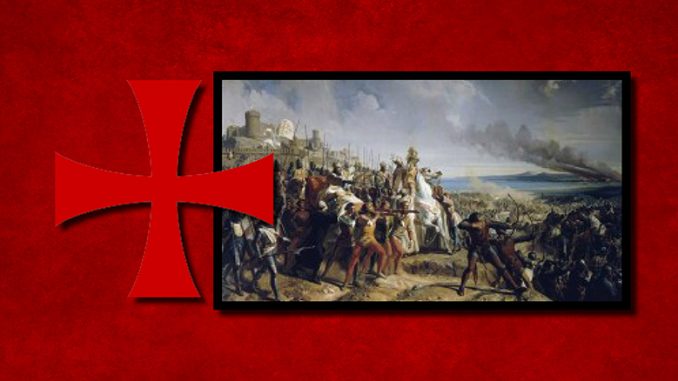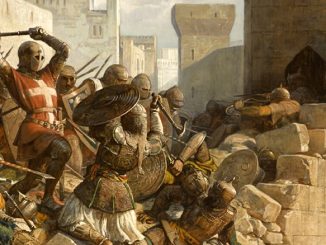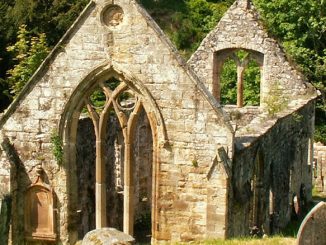
Above Battle of Montgisard by Charles-Philippe Larivière
Battle of Montgisard by Stephen Dafoe
The following article, part one in a series on Templar Battles, is adopted from Stephen Dafoe’s book Nobly Born: An Illustrated History of the Knights Templar, published by Lewis Masonic.
When King Baldwin IV reached the age of 16 in 1177, Count Raymond of Tripoli’s regency of the Kingdom of Jerusalem came to an end. Now in power, the leper king immediately became involved in military campaigns, despite his growing illness. When Philip of Flanders decided to go north to help Raymond in a campaign against the Muslims, Baldwin sent one thousand knights and two thousand foot soldiers to assist, as well as a number of Templars. This left the kingdom with far fewer men than they had sent and Saladin quickly learned of the kingdom’s weakened condition.
On November 18, 1177, Saladin crossed into Christian territory with a massive army said to have been composed of twenty-six thousand light cavalry, eight thousand men on camels and an additional one thousand men who formed Saladin’s bodyguard. Knowing that his army greatly outnumbered the Christians, Saladin confidently began his northward march up the Palestinian coast. However, the kingdom was not without its own intelligence and as soon as word arrived that the sultan was on the move, Odo de St Amand, who was then Master of the Templars, ordered every knight he could gather to move south to Gaza to fend off the Muslims.
Saladin, perhaps realizing that the Templars would respond in such a manner, sailed on past Gaza and set out to besiege Ascalon, which had been captured two decades earlier. Baldwin, who had been able to gather about five hundred knights, headed straight for the port city, arriving a few hours before Saladin and his army. But Saladin once again changed his plans. Since the Templars were guarding Gaza and the king and his men were guarding Ascalon, the sultan realized that the road between him and Jerusalem lay empty of his Christian enemies. Leaving a small contingent to keep Baldwin occupied, Saladin moved north towards Jerusalem, his mouth surely salivating at the prospect of capturing the Holy City. But overconfidence caused Saladin to let his guard down. The normally tight rein he kept on his men was loosened and they were allowed to wander and pillage the countryside.
Baldwin somehow managed to get word to the Templar garrison at Gaza as to what was happening. His messenger told the Templars there to abandon Gaza and head north to Ascalon to help their king. When the Templars arrived at Ascalon, Baldwin along with Reynald de Châtillon and the army flew out of the city and the united Christian forces moved north to Ibelin, where they swung inland towards Jerusalem.
Exactly one week after he had crossed over from Egypt, Saladin and his army were crossing a ravine near Montgisard, southeast of Jerusalem, when the Christians came crashing down on them from the north. Saladin had no idea what was coming his way.
With the element of surprise on their side, the Christians, despite being incredibly outnumbered, were able to send Saladin’s army from the field of battle. The victory was owed to the Templars and their heavy charge, led by Odo de St Amand and eighty of his brethren. Ralph of Diss in chronicling an eyewitness account of the Battle of Montgisard wrote of the devastating effect of the Templars’ charge:
‘Spurring all together, as one man, they [the Templars] made a charge, turning neither to the left nor to the right. Recognizing the battalion in which Saladin commanded many knights, they manfully approached it, immediately penetrated it, incessantly knocked down, scattered, struck and crushed. Saladin was smitten with admiration, seeing his men dispersed everywhere, everywhere turned in flight, everywhere given to the mouth of the sword.’
Many of Saladin’s men left the field before the first wave of the Templars’ charge hit; those who had the courage to hold their positions were all but destroyed by the Christians. Soon the Egyptian army was in flight, abandoning not only the booty they had captured as the pillaged their way towards Jerusalem, but also many of their own weapons. If the humiliation in the field was not enough, the journey home only added to it. As the army crossed the Sinai Desert, they were regularly harassed by Bedouins, while others who stopped in villages to beg for food and water were slain or handed over to the Christians as captives.
As for Saladin, ever concerned that his position of power might be upset, he sent messengers ahead to Egypt, mounted on speeding camels, to let everyone know that he was very much still among the living. Upon his return carrier pigeons were sent throughout the land to let the Egyptians know that their sultan had returned.
In the end, Saladin failed to capture Jerusalem as he had hoped, largely due to the courage of Jerusalem’s leper king and the skill and discipline of the Templars under Odo de St Armand. However, whatever humiliation Saladin had faced at Montgisard in the autumn of 1177; it would be long forgotten a decade later when the Holy City would finally be his.
About Us
We hope you enjoyed this article on the Battle of Montgisard.
TemplarHistory.com was started in the fall of 1997 by Stephen Dafoe, a Canadian author who has written several books on the Templars and related subjects.
Read more from our Templar History Archives – Templar History



